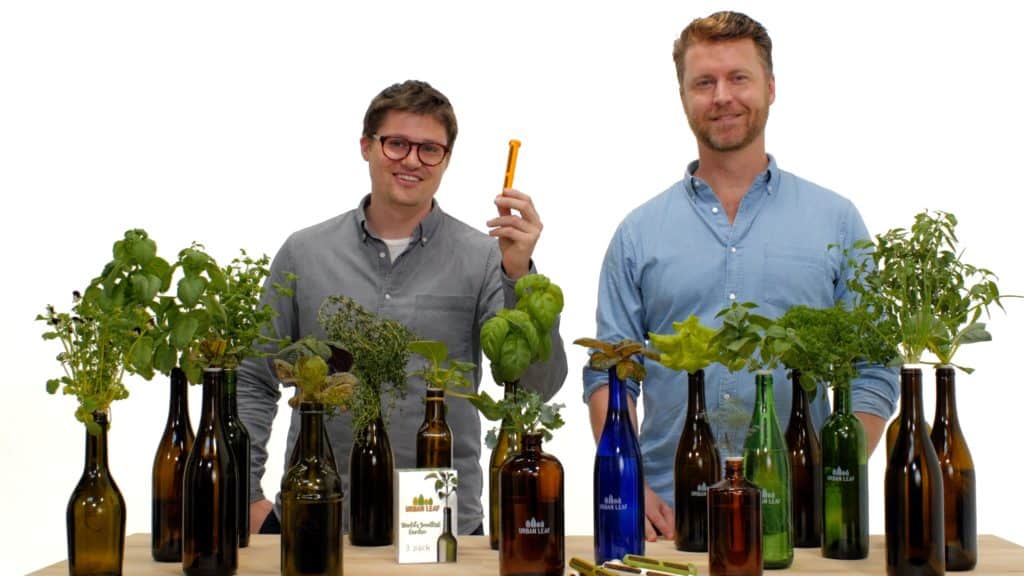 |
| The World’s Smallest Garden |
After meeting at Columbia University in early 2016, the co-founders combined their skills in business and food growing systems to launch this first product, which is intended for beginning growers to use in their home. Setup for the product should only take about 60 seconds, by placing the small, biodegradable plastic device into the top of a bottle—such as a whiskey or wine bottle.
With UrbanLeaf, Littlewood and Elliott hope to create an experience which helps people reconnect with their food. Food Tank had a chance to speak with Nate Littlewood about the inspiration behind UrbanLeaf and challenges he and his partner have faced along the way.
What was the inspiration that led to creating the UrbanLeaf product?
Nathan Littlewood (NL): We wanted to show people that growing food at home could be fun, easy, and accessible. Through over 200 customer interviews, we feel we’ve developed a pretty good handle on the sorts of challenges and obstacles that amateur urban farmers face.
Nine times out of ten, home gardens fail because people forget to water them. The World’s Smallest Garden solves this problem in the simplest, most elegant, and cost-effective way we could imagine. It provides a way for plants to water themselves. We also like that it repurposes something that is available locally (an empty bottle) to create the hydroponic reservoir. In doing so, we eliminate the need to make an injection molded plastic reservoir and import it from overseas. The small amount of plastic we do use in our product is biodegradable. It costs us a bit more, but we feel this is money well spent.
What has been your biggest challenge in developing UrbanLeaf?
NL: It’s been really hard finding hardware know-how and expertise here in New York. There’s a ton of people that understand tech and services based businesses, but widget producers are few and far between! We were recently accepted into FutureWorks, which is a hardware-specific Incubator Program. It seems like an amazing community and we’re looking forward to getting more involved!
How do hydroponics contribute to a more sustainable food system?
NL: Hydroponics opens up new possibilities for food-system design. It doesn’t rely on clearing land, soil quality, large open spaces, and the right season. Hydroponics is very well suited to growing food in urban environments. It’s stackable, it can go vertical, and it can be modular. It allows us to conceive food system designs that involve shorter supply chains, fewer food miles, less weather vulnerability, less wastage, and less packaging.

What piece of advice would you give to early entrepreneurs trying to make an impact in the food system?
NL: Emily, you’d know better than most about the level of interest growing around food and sustainability—and I’m sure you’ll agree that this is a good thing. Whilst it’s encouraging to see so many bright, talented, and motivated people entering this space, coming from a business background, I do worry that food businesses generally have low barriers to entry. I fear that a lot of people are going to burn a lot of capital over the next 5 to 10 years learning hard lessons about the importance of competitive advantage. As a producer of consumer hydroponics products, this is something I worry about more than most! My advice is to remember that you can’t pay your rent with passion—most landlords require dollars.
What inspires you to keep working towards food system change every day?
NL: When I’m an old man, and I tell my grandchildren what I’ve done with my life, I want them to be so excited about the answer that they go to school the next day and tell all their friends about it. I’m only in my 30s, so the grandkids are some way off, but the quality of the environmental legacy that I leave behind for them is why I’m doing this. I want them to be able to enjoy the great outdoors in the same way I have. I’m also 100-percent confident that we can improve the quality of thousands of peoples’ lives along the way by providing an experience that helps them reconnect with food.
You’ve mentioned that The World’s Smallest Garden is only a first step towards building a future where food is fresh, local, and personal. What is your vision for UrbanLeaf down the road?
NL: Our goal is to make our customers happy, and to show people that growing their own food can be fun, easy, and accessible. The World’s Smallest Garden is the perfect product to start with both for us as a company and for consumers who are new to this space. Ultimately we want to grow with our customers, and we have a really exciting pipeline of new products that we’ll be releasing over the next few years. I’ll tell you more about that in our next interview!










No comments:
Post a Comment